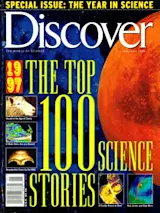The Pioneer 10 space probe—the farthest-traveling man-made object in the universe—came to the end of its mission this past year, after a quarter of a century of scientific exploration. When NASA launched it in 1972, the probe was meant to survive only a 21-month mission to Jupiter. Crossing the asteroid belt without incident was its first achievement; then it sent us the first close-up photographs and scientific measurements of Jupiter, confirming that the giant planet is mostly gas and liquid. Curving past Jupiter, it became the first spacecraft to use a planet’s gravitation to fling itself along, a maneuver that later became standard procedure. Finally it showed that our solar system is larger than previously thought: when the mission ended, with the probe 6.2 billion miles from Earth, it was still detecting solar-wind particles, indicating that it had not yet crossed the heliopause—the boundary between the solar system and interstellar space.
Mission planners had hoped to find that boundary, but by last March only 6 of Pioneer’s 12 instruments worked, and there was only enough power to operate one of them. There was still interesting information coming back, but it takes several million dollars to operate the spacecraft, says Larry Lasher, project manager at the NASA Ames Research Center in Mountain View, California. So nasa decided to stop spending the money on sending commands to the probe and analyzing its data and formally ended the mission. Controllers at Ames, however, will continue listening to Pioneer’s faint radio beeps until its battery finally dies next spring; they’re using that signal to train for a future lunar mission. By this fortunate circumstance we are able to keep in touch with Pioneer, says Lasher. I think when it stops its signal, that will be the end of an icon—like the heartbeat’s stopped.
Even so, the spacecraft will fly on, headed for the star Aldebaran, some 68 light-years and a 2-million-year journey away. Lasher is confident Pioneer will make it to Aldebaran and beyond; the space it must traverse is fairly empty, so a collision is unlikely. Thus the probe’s informal mission will continue: its famous plaque of gold-plated aluminum, depicting a man and a woman, the path of the probe, and the sun’s location in the galaxy, is presumably still intact. We came of age by sending a representation of us into outer space, says Lasher. If it were ever found, it would be wonderful. But it’s a big space out there, a big galaxy, a big universe.














